Documents
Illinois State Rep. Margaret Croke Email to Sheriff’s Office With Draft Bills
Nov. 13 2022 — 8:58 a.m.
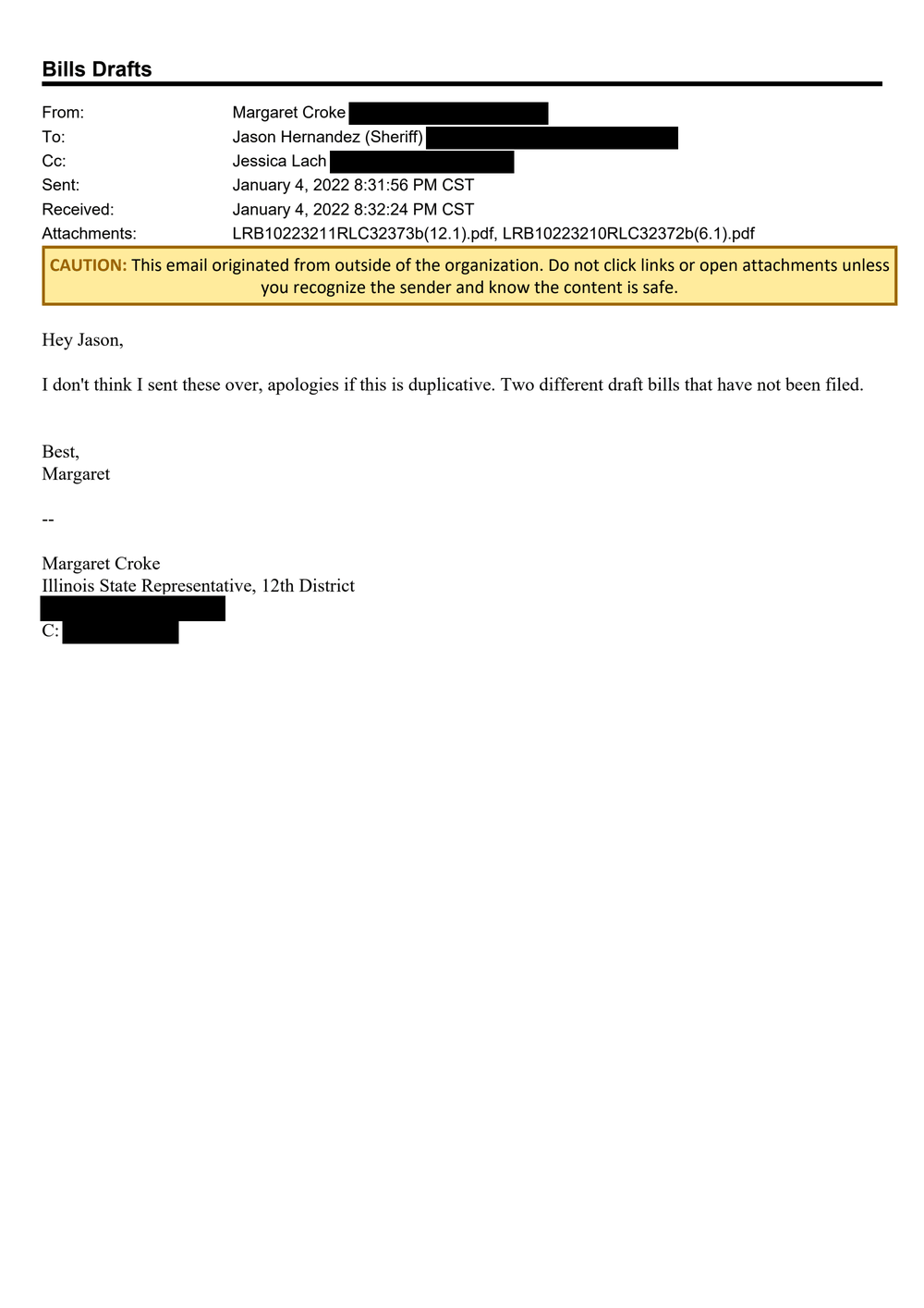
Bills Drafts
From: Margaret Croke
To: Jason Hernandez (Sheriff)
Cc: Jessica Lach
Sent: January 4, 2022 8:31:56 PM CST
Received: January 4, 2022 8:32:24 PM CST
Attachments: LRB10223211RLC32373b(12.1).pdf, LRB10223210RLC32372b(6.1).pdf
CAUTION: This email originated from outside of the organization. Do not click links or open attachments unless
you recognize the sender and know the content is safe.
Hey Jason,
I don't think I sent these over, apologies if this is duplicative. Two different draft bills that have not been filed.
Best,
Margaret
--
Margaret Croke
Illinois State Representative, 12th District
C:

102ND GENERAL ASSEMBLY
State of Illinois
2021 and 2022
INTRODUCED ________________, BY
SYNOPSIS AS INTRODUCED:
730 ILCS 5/5-8A-2 from Ch. 38, par. 1005-8A-2
730 ILCS 5/5-8A-3 from Ch. 38, par. 1005-8A-3
Amends the Unified Code of Corrections. Provides that a person who has
been convicted of first degree murder, attempted first degree murder,
reckless homicide, being an armed habitual criminal, aggravated vehicular
hijacking in which the defendant was armed with a firearm or other
dangerous weapon, domestic battery, aggravated domestic battery, or any
offense that requires the defendant to register as a sex offender under the
Sex Offender Registration Act and has been placed in an electronic
monitoring or home detention program may not have free unrestricted
liberty during 7am to 7pm and shall have restrictions on his or her
liberties such as curfews during that period in addition to 7pm to 7am.
restrictions. Effective immediately.
LRB102 23211 RLC 32373 b
A BILL FOR
*LRB10223211RLC32373b*
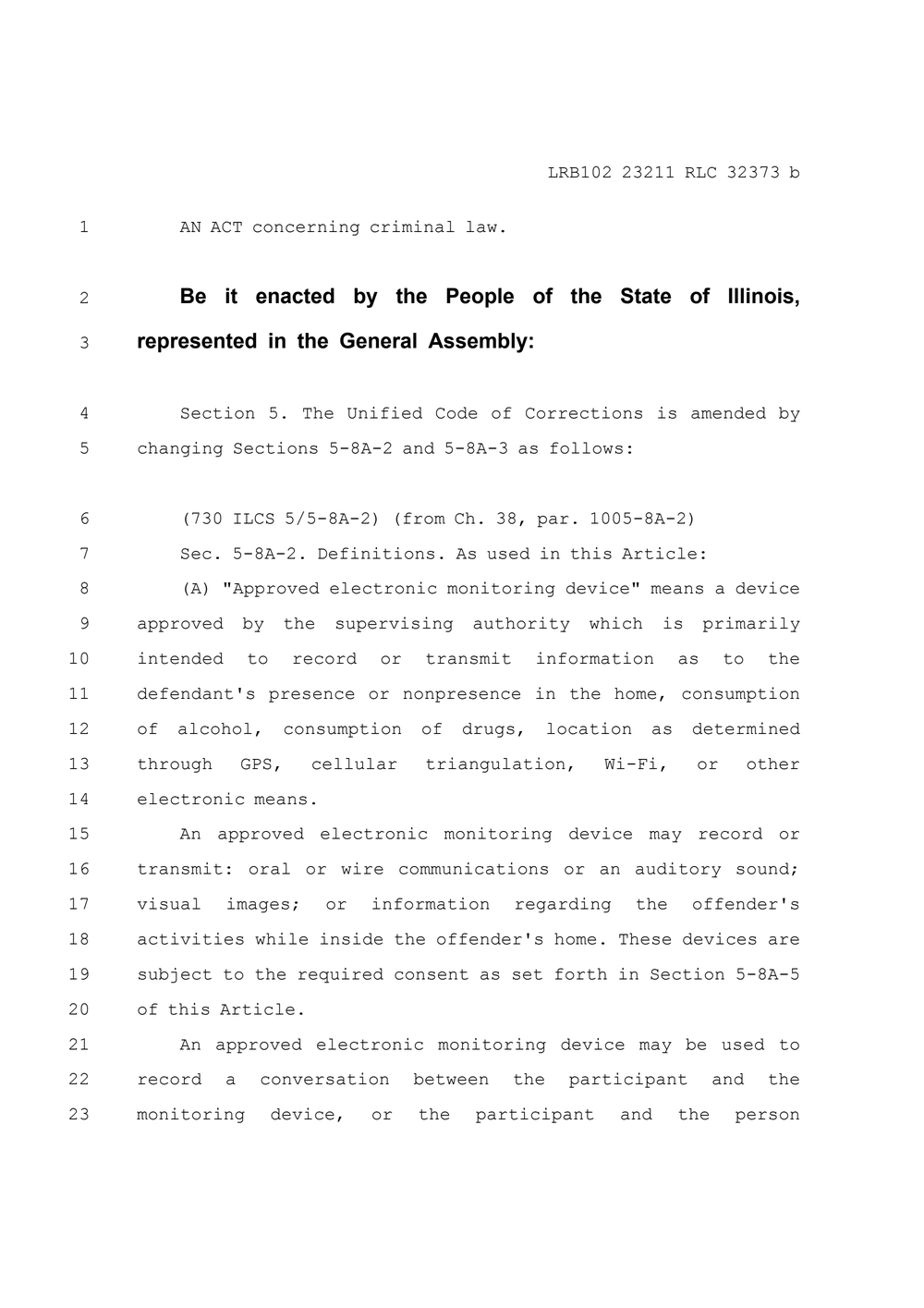
AN ACT concerning criminal law.
Be it enacted by the People of the State of Illinois,
represented in the General Assembly:
Section 5. The Unified Code of Corrections is amended by
changing Sections 5-8A-2 and 5-8A-3 as follows:
(730 ILCS 5/5-8A-2) (from Ch. 38, par. 1005-8A-2)
Sec. 5-8A-2. Definitions. As used in this Article:
(A) "Approved electronic monitoring device" means a device
approved by the supervising authority which is primarily
intended to record or transmit information as to the
defendant's presence or nonpresence in the home, consumption
of alcohol, consumption of drugs, location as determined
through GPS, cellular triangulation, Wi-Fi, or other
electronic means.
An approved electronic monitoring device may record or
transmit: oral or wire communications or an auditory sound;
visual images; or information regarding the offender's
activities while inside the offender's home. These devices are
subject to the required consent as set forth in Section 5-8A-5
of this Article.
An approved electronic monitoring device may be used to
record a conversation between the participant and the
monitoring device, or the participant and the person
1
2
3
4
5
6
7
8
9
10
11
12
13
14
15
16
17
18
19
20
21
22
23
LRB102 23211 RLC 32373 b
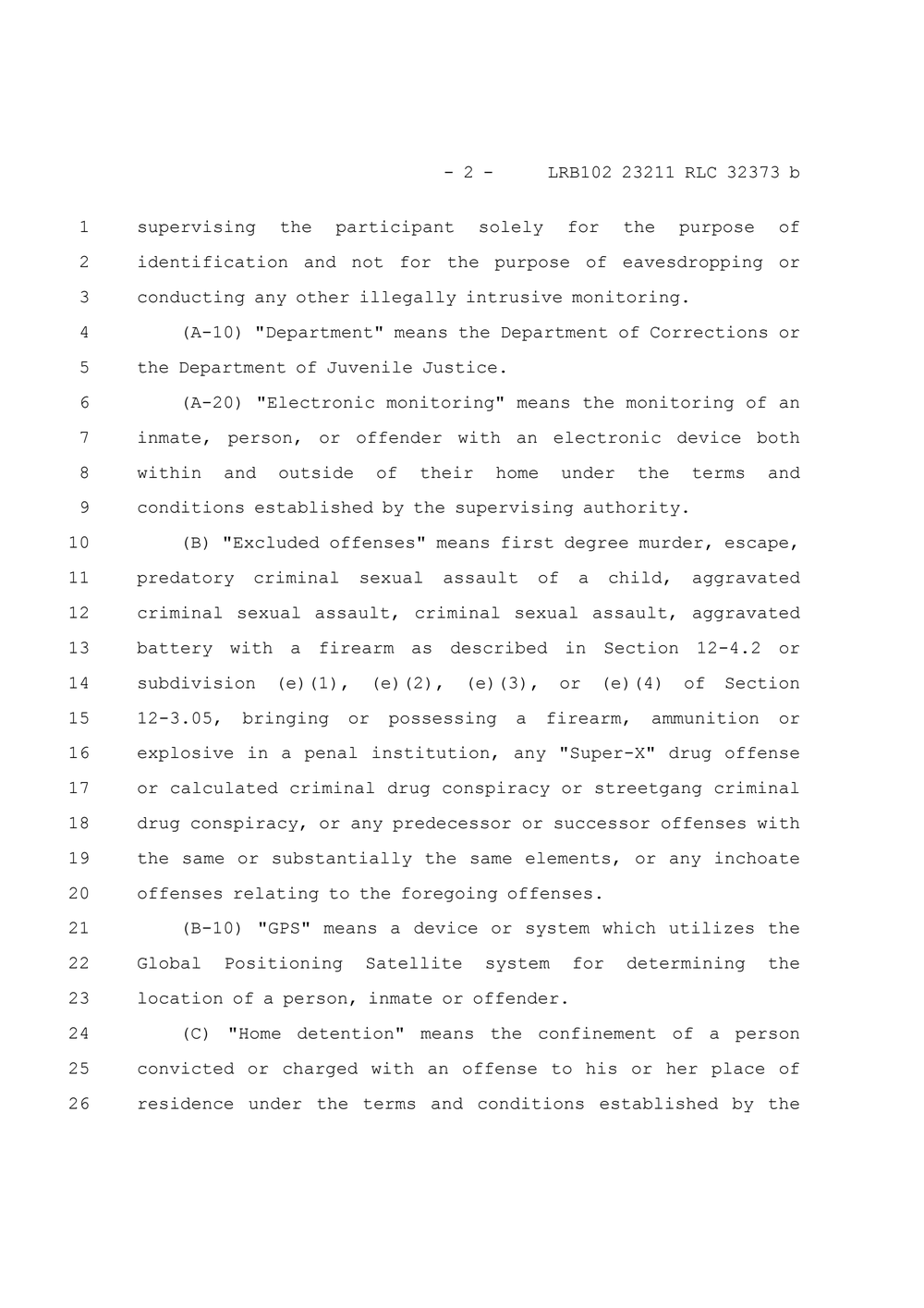
supervising the participant solely for the purpose of
identification and not for the purpose of eavesdropping or
conducting any other illegally intrusive monitoring.
(A-10) "Department" means the Department of Corrections or
the Department of Juvenile Justice.
(A-20) "Electronic monitoring" means the monitoring of an
inmate, person, or offender with an electronic device both
within and outside of their home under the terms and
conditions established by the supervising authority.
(B) "Excluded offenses" means first degree murder, escape,
predatory criminal sexual assault of a child, aggravated
criminal sexual assault, criminal sexual assault, aggravated
battery with a firearm as described in Section 12-4.2 or
subdivision (e)(1), (e)(2), (e)(3), or (e)(4) of Section
12-3.05, bringing or possessing a firearm, ammunition or
explosive in a penal institution, any "Super-X" drug offense
or calculated criminal drug conspiracy or streetgang criminal
drug conspiracy, or any predecessor or successor offenses with
the same or substantially the same elements, or any inchoate
offenses relating to the foregoing offenses.
(B-10) "GPS" means a device or system which utilizes the
Global Positioning Satellite system for determining the
location of a person, inmate or offender.
(C) "Home detention" means the confinement of a person
convicted or charged with an offense to his or her place of
residence under the terms and conditions established by the
1
2
3
4
5
6
7
8
9
10
11
12
13
14
15
16
17
18
19
20
21
22
23
24
25
26
- 2 - LRB102 23211 RLC 32373 b
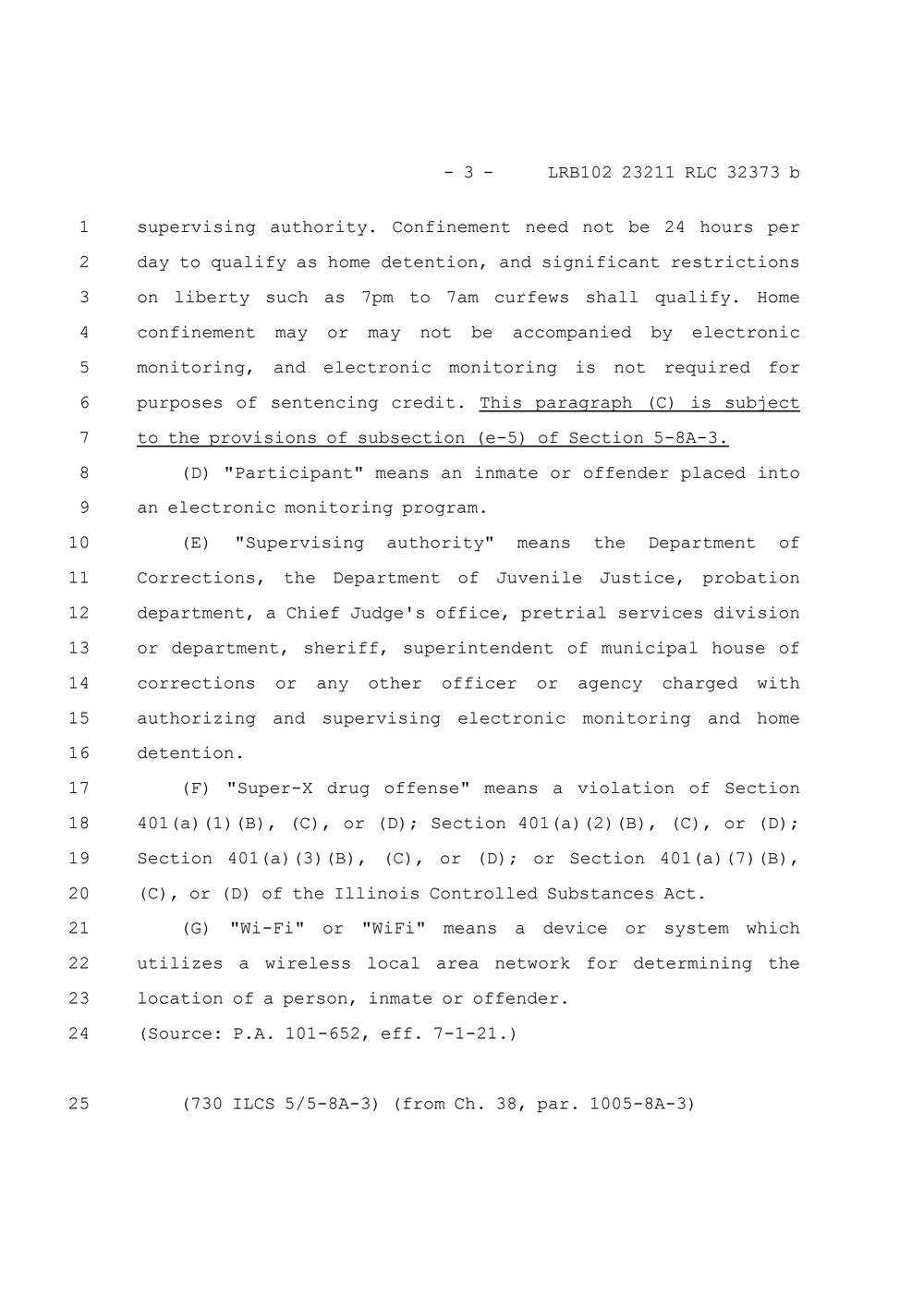
supervising authority. Confinement need not be 24 hours per
day to qualify as home detention, and significant restrictions
on liberty such as 7pm to 7am curfews shall qualify. Home
confinement may or may not be accompanied by electronic
monitoring, and electronic monitoring is not required for
purposes of sentencing credit. This paragraph (C) is subject
to the provisions of subsection (e-5) of Section 5-8A-3.
(D) "Participant" means an inmate or offender placed into
an electronic monitoring program.
(E) "Supervising authority" means the Department of
Corrections, the Department of Juvenile Justice, probation
department, a Chief Judge's office, pretrial services division
or department, sheriff, superintendent of municipal house of
corrections or any other officer or agency charged with
authorizing and supervising electronic monitoring and home
detention.
(F) "Super-X drug offense" means a violation of Section
401(a)(1)(B), (C), or (D); Section 401(a)(2)(B), (C), or (D);
Section 401(a)(3)(B), (C), or (D); or Section 401(a)(7)(B),
(C), or (D) of the Illinois Controlled Substances Act.
(G) "Wi-Fi" or "WiFi" means a device or system which
utilizes a wireless local area network for determining the
location of a person, inmate or offender.
(Source: P.A. 101-652, eff. 7-1-21.)
(730 ILCS 5/5-8A-3) (from Ch. 38, par. 1005-8A-3)
1
2
3
4
5
6
7
8
9
10
11
12
13
14
15
16
17
18
19
20
21
22
23
24
25
- 3 - LRB102 23211 RLC 32373 b

Sec. 5-8A-3. Application.
(a) Except as provided in subsection (d), a person charged
with or convicted of an excluded offense may not be placed in
an electronic monitoring or home detention program, except for
bond pending trial or appeal or while on parole, aftercare
release, or mandatory supervised release.
(b) A person serving a sentence for a conviction of a Class
1 felony, other than an excluded offense, may be placed in an
electronic monitoring or home detention program for a period
not to exceed the last 90 days of incarceration.
(c) A person serving a sentence for a conviction of a Class
X felony, other than an excluded offense, may be placed in an
electronic monitoring or home detention program for a period
not to exceed the last 90 days of incarceration, provided that
the person was sentenced on or after August 11, 1993 (the
effective date of Public Act 88-311) and provided that the
court has not prohibited the program for the person in the
sentencing order.
(d) A person serving a sentence for conviction of an
offense other than for predatory criminal sexual assault of a
child, aggravated criminal sexual assault, criminal sexual
assault, aggravated criminal sexual abuse, or felony criminal
sexual abuse, may be placed in an electronic monitoring or
home detention program for a period not to exceed the last 12
months of incarceration, provided that (i) the person is 55
years of age or older; (ii) the person is serving a determinate
1
2
3
4
5
6
7
8
9
10
11
12
13
14
15
16
17
18
19
20
21
22
23
24
25
26
- 4 - LRB102 23211 RLC 32373 b
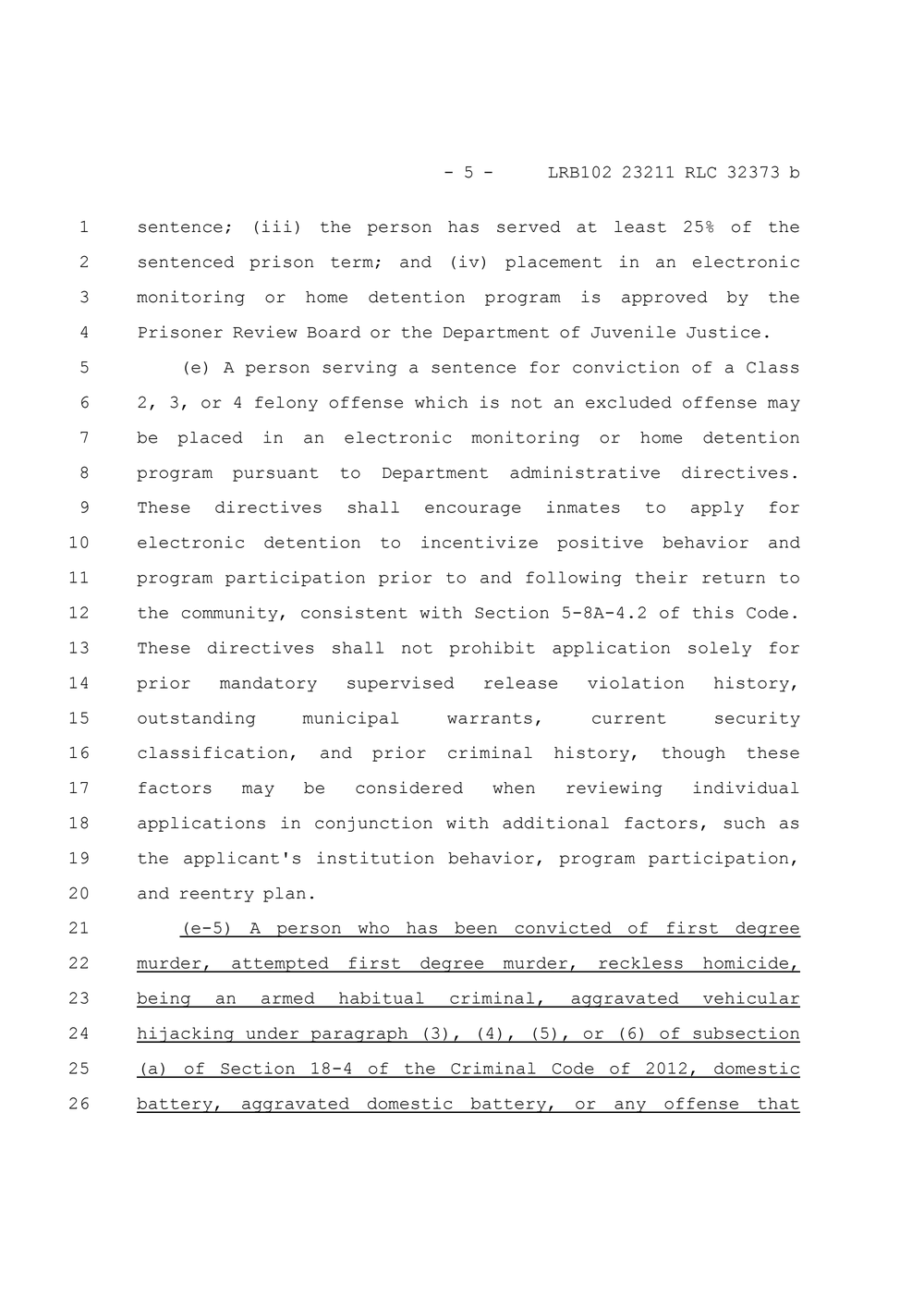
sentence; (iii) the person has served at least 25% of the
sentenced prison term; and (iv) placement in an electronic
monitoring or home detention program is approved by the
Prisoner Review Board or the Department of Juvenile Justice.
(e) A person serving a sentence for conviction of a Class
2, 3, or 4 felony offense which is not an excluded offense may
be placed in an electronic monitoring or home detention
program pursuant to Department administrative directives.
These directives shall encourage inmates to apply for
electronic detention to incentivize positive behavior and
program participation prior to and following their return to
the community, consistent with Section 5-8A-4.2 of this Code.
These directives shall not prohibit application solely for
prior mandatory supervised release violation history,
outstanding municipal warrants, current security
classification, and prior criminal history, though these
factors may be considered when reviewing individual
applications in conjunction with additional factors, such as
the applicant's institution behavior, program participation,
and reentry plan.
(e-5) A person who has been convicted of first degree
murder, attempted first degree murder, reckless homicide,
being an armed habitual criminal, aggravated vehicular
hijacking under paragraph (3), (4), (5), or (6) of subsection
(a) of Section 18-4 of the Criminal Code of 2012, domestic
battery, aggravated domestic battery, or any offense that
1
2
3
4
5
6
7
8
9
10
11
12
13
14
15
16
17
18
19
20
21
22
23
24
25
26
- 5 - LRB102 23211 RLC 32373 b
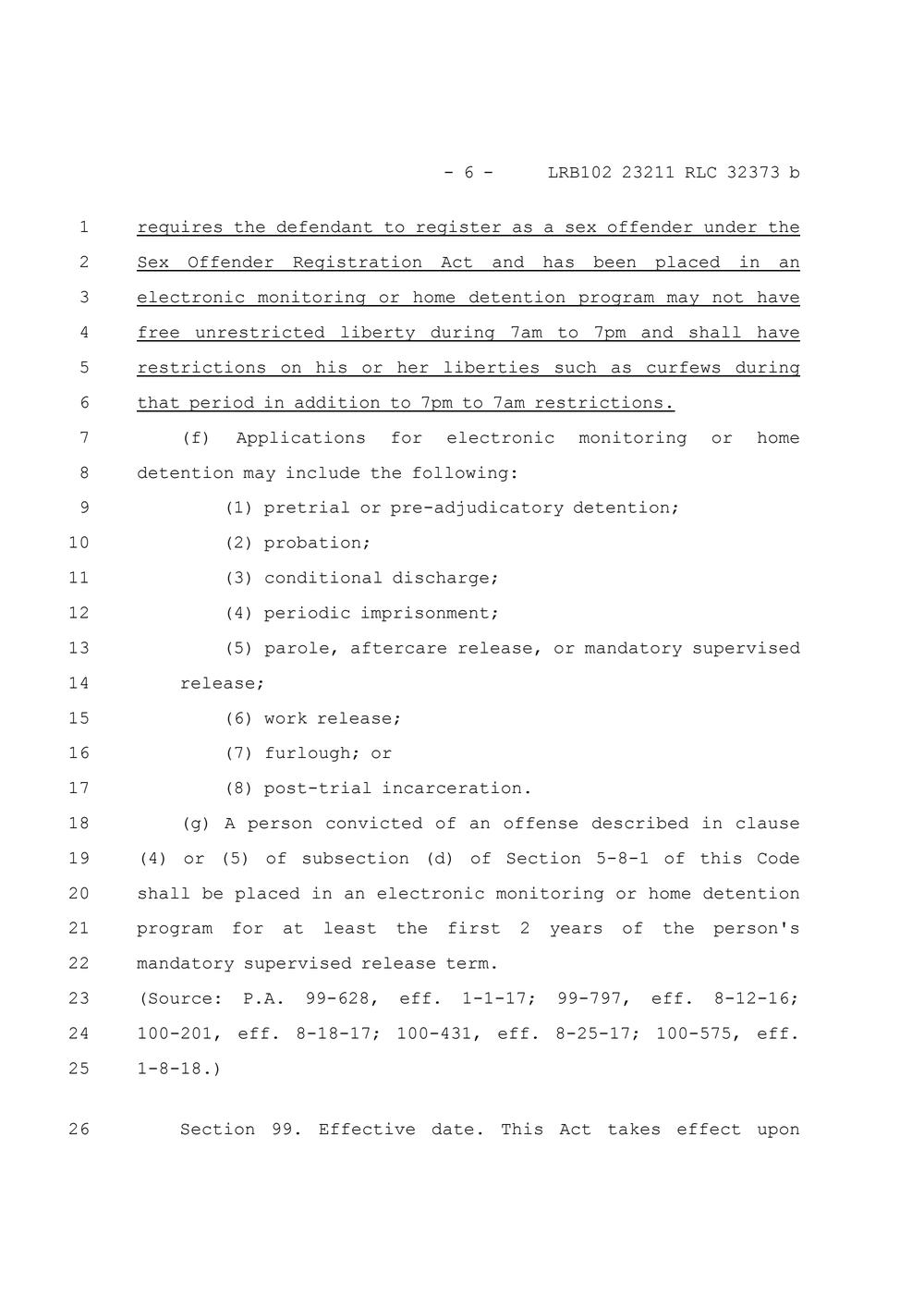
requires the defendant to register as a sex offender under the
Sex Offender Registration Act and has been placed in an
electronic monitoring or home detention program may not have
free unrestricted liberty during 7am to 7pm and shall have
restrictions on his or her liberties such as curfews during
that period in addition to 7pm to 7am restrictions.
(f) Applications for electronic monitoring or home
detention may include the following:
(1) pretrial or pre-adjudicatory detention;
(2) probation;
(3) conditional discharge;
(4) periodic imprisonment;
(5) parole, aftercare release, or mandatory supervised
release;
(6) work release;
(7) furlough; or
(8) post-trial incarceration.
(g) A person convicted of an offense described in clause
(4) or (5) of subsection (d) of Section 5-8-1 of this Code
shall be placed in an electronic monitoring or home detention
program for at least the first 2 years of the person's
mandatory supervised release term.
(Source: P.A. 99-628, eff. 1-1-17; 99-797, eff. 8-12-16;
100-201, eff. 8-18-17; 100-431, eff. 8-25-17; 100-575, eff.
1-8-18.)
Section 99. Effective date. This Act takes effect upon
1
2
3
4
5
6
7
8
9
10
11
12
13
14
15
16
17
18
19
20
21
22
23
24
25
26
- 6 - LRB102 23211 RLC 32373 b
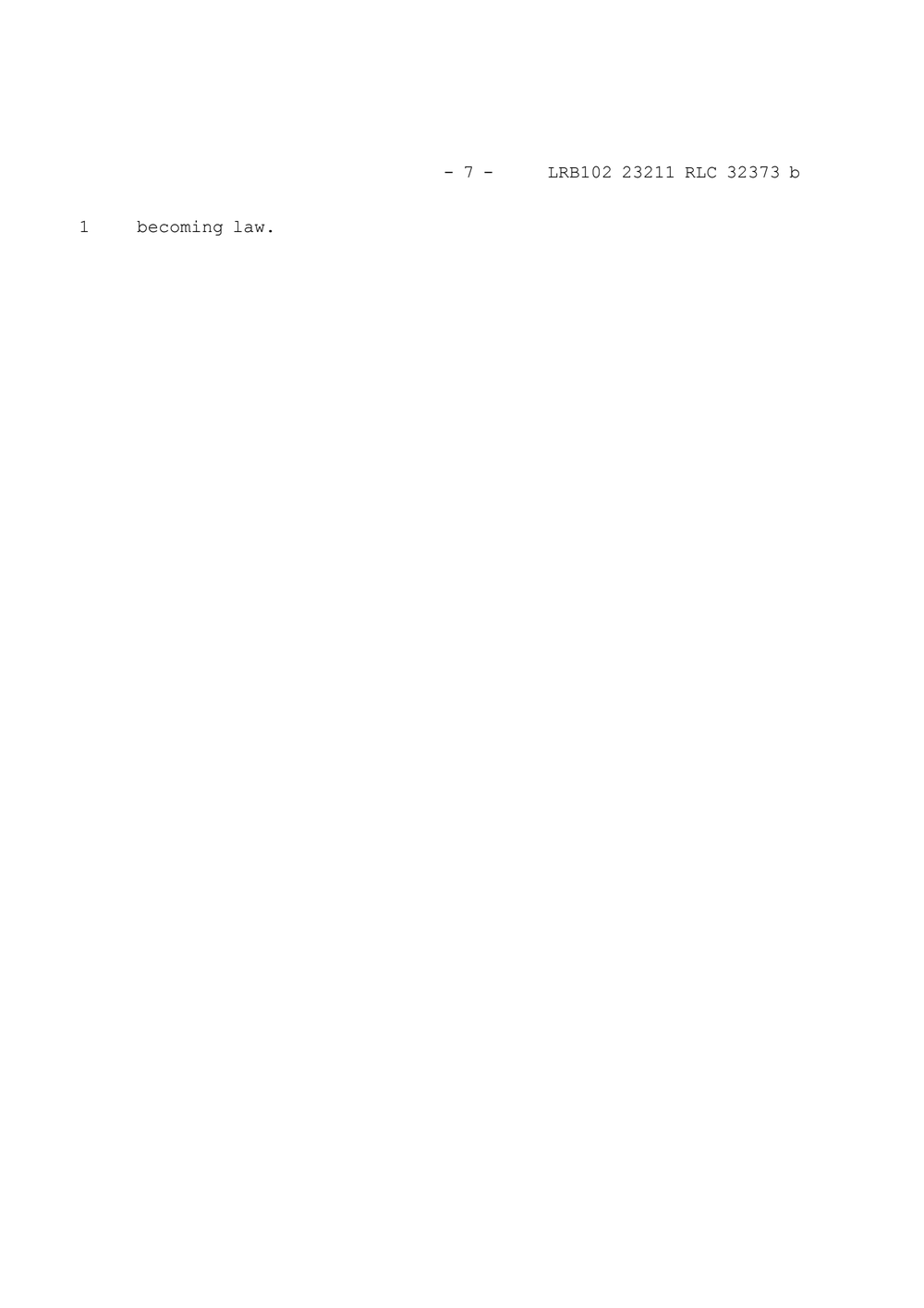
1 becoming law.
- 7 - LRB102 23211 RLC 32373 b
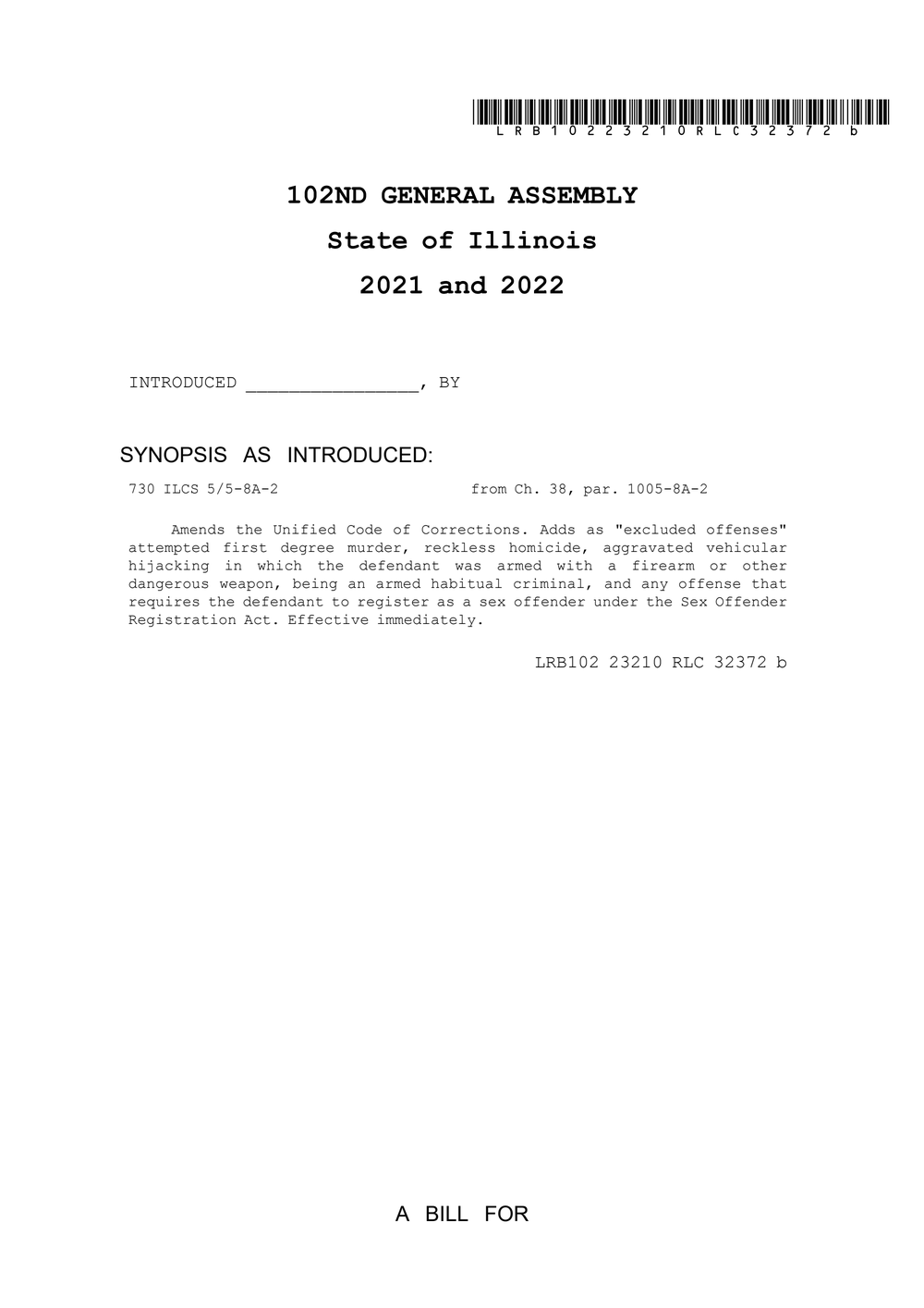
102ND GENERAL ASSEMBLY
State of Illinois
2021 and 2022
INTRODUCED ________________, BY
SYNOPSIS AS INTRODUCED:
730 ILCS 5/5-8A-2 from Ch. 38, par. 1005-8A-2
Amends the Unified Code of Corrections. Adds as "excluded offenses"
attempted first degree murder, reckless homicide, aggravated vehicular
hijacking in which the defendant was armed with a firearm or other
dangerous weapon, being an armed habitual criminal, and any offense that
requires the defendant to register as a sex offender under the Sex Offender
Registration Act. Effective immediately.
LRB102 23210 RLC 32372 b
A BILL FOR
*LRB10223210RLC32372b*
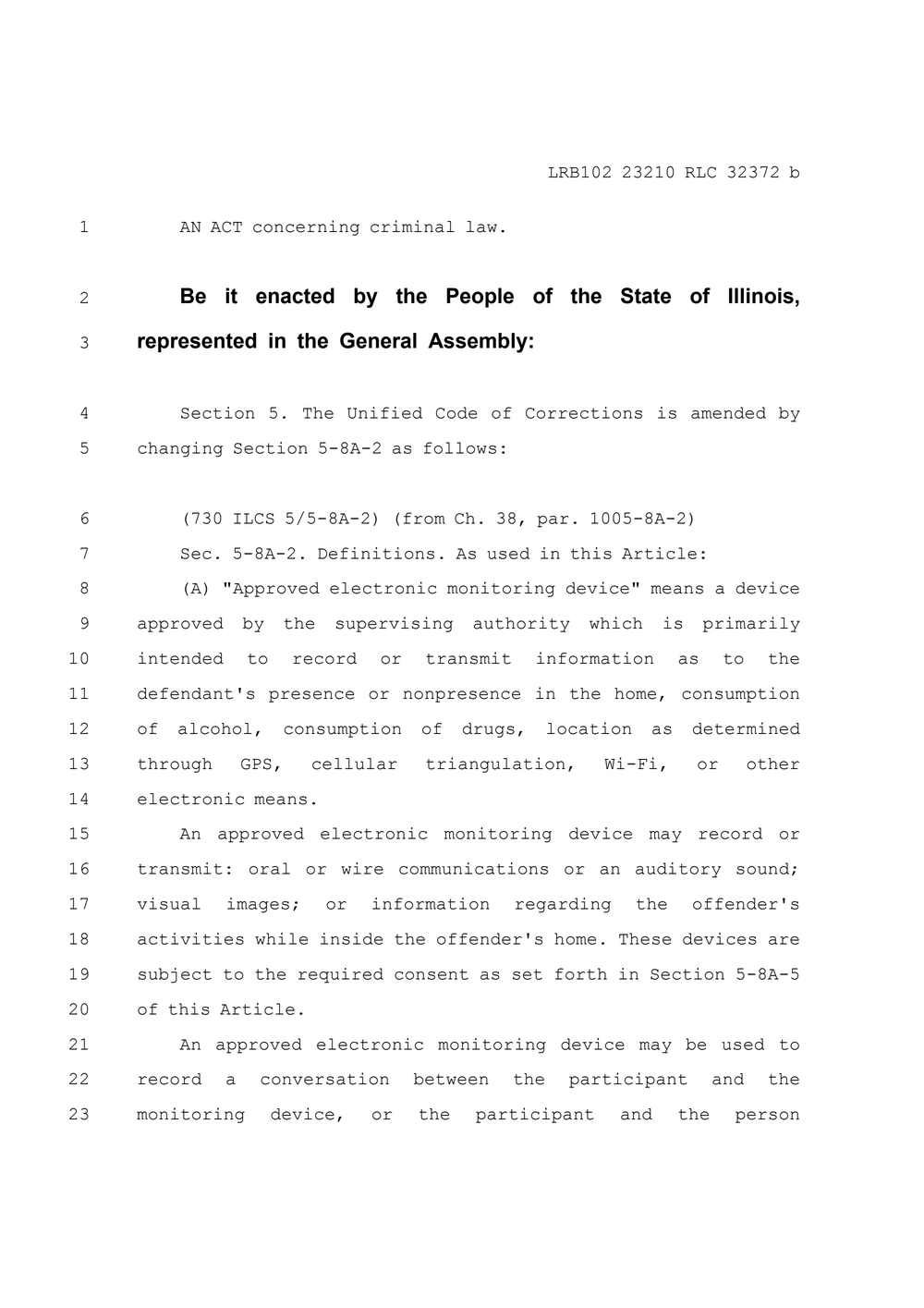
AN ACT concerning criminal law.
Be it enacted by the People of the State of Illinois,
represented in the General Assembly:
Section 5. The Unified Code of Corrections is amended by
changing Section 5-8A-2 as follows:
(730 ILCS 5/5-8A-2) (from Ch. 38, par. 1005-8A-2)
Sec. 5-8A-2. Definitions. As used in this Article:
(A) "Approved electronic monitoring device" means a device
approved by the supervising authority which is primarily
intended to record or transmit information as to the
defendant's presence or nonpresence in the home, consumption
of alcohol, consumption of drugs, location as determined
through GPS, cellular triangulation, Wi-Fi, or other
electronic means.
An approved electronic monitoring device may record or
transmit: oral or wire communications or an auditory sound;
visual images; or information regarding the offender's
activities while inside the offender's home. These devices are
subject to the required consent as set forth in Section 5-8A-5
of this Article.
An approved electronic monitoring device may be used to
record a conversation between the participant and the
monitoring device, or the participant and the person
1
2
3
4
5
6
7
8
9
10
11
12
13
14
15
16
17
18
19
20
21
22
23
LRB102 23210 RLC 32372 b
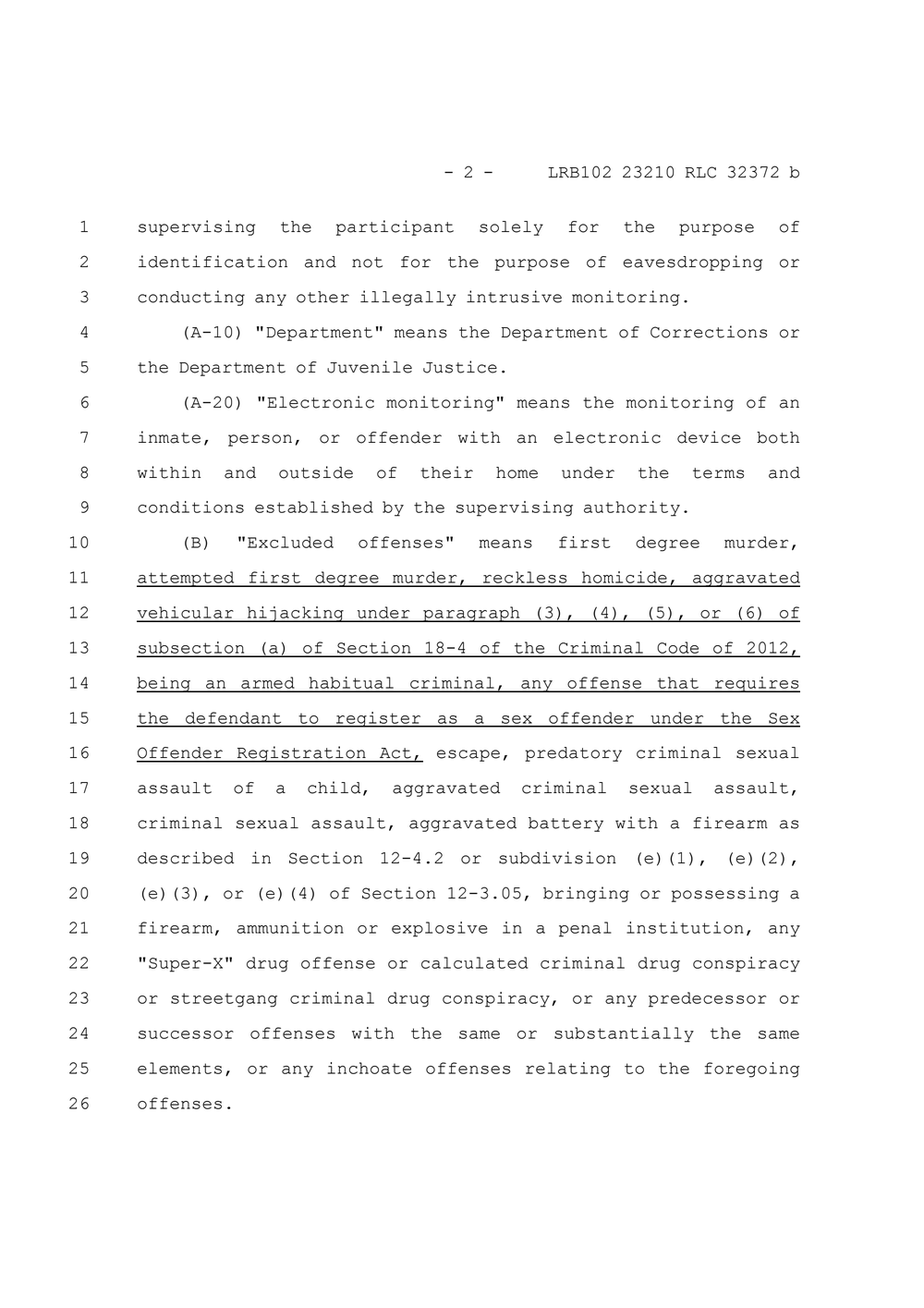
supervising the participant solely for the purpose of
identification and not for the purpose of eavesdropping or
conducting any other illegally intrusive monitoring.
(A-10) "Department" means the Department of Corrections or
the Department of Juvenile Justice.
(A-20) "Electronic monitoring" means the monitoring of an
inmate, person, or offender with an electronic device both
within and outside of their home under the terms and
conditions established by the supervising authority.
(B) "Excluded offenses" means first degree murder,
attempted first degree murder, reckless homicide, aggravated
vehicular hijacking under paragraph (3), (4), (5), or (6) of
subsection (a) of Section 18-4 of the Criminal Code of 2012,
being an armed habitual criminal, any offense that requires
the defendant to register as a sex offender under the Sex
Offender Registration Act, escape, predatory criminal sexual
assault of a child, aggravated criminal sexual assault,
criminal sexual assault, aggravated battery with a firearm as
described in Section 12-4.2 or subdivision (e)(1), (e)(2),
(e)(3), or (e)(4) of Section 12-3.05, bringing or possessing a
firearm, ammunition or explosive in a penal institution, any
"Super-X" drug offense or calculated criminal drug conspiracy
or streetgang criminal drug conspiracy, or any predecessor or
successor offenses with the same or substantially the same
elements, or any inchoate offenses relating to the foregoing
offenses.
1
2
3
4
5
6
7
8
9
10
11
12
13
14
15
16
17
18
19
20
21
22
23
24
25
26
- 2 - LRB102 23210 RLC 32372 b
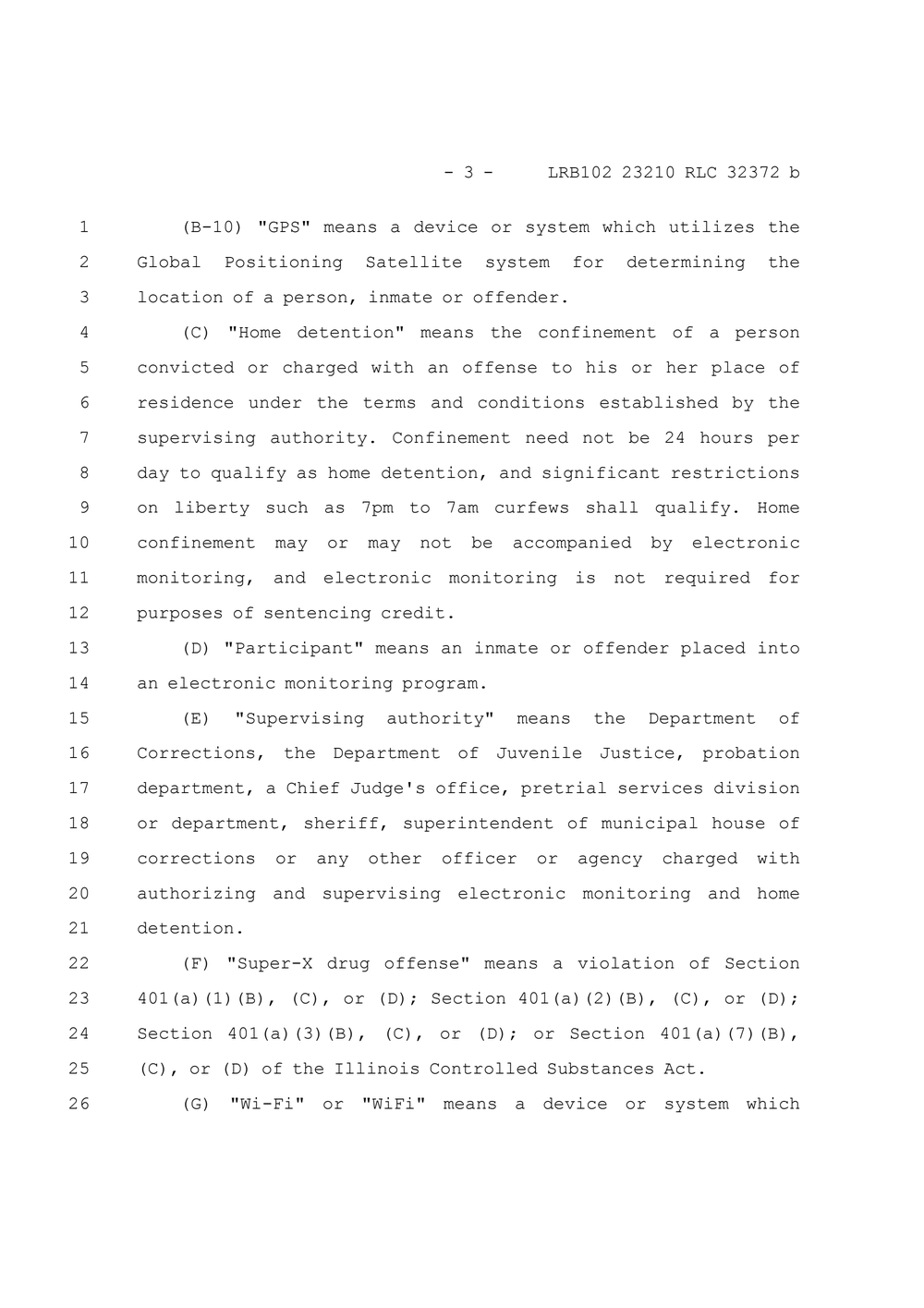
(B-10) "GPS" means a device or system which utilizes the
Global Positioning Satellite system for determining the
location of a person, inmate or offender.
(C) "Home detention" means the confinement of a person
convicted or charged with an offense to his or her place of
residence under the terms and conditions established by the
supervising authority. Confinement need not be 24 hours per
day to qualify as home detention, and significant restrictions
on liberty such as 7pm to 7am curfews shall qualify. Home
confinement may or may not be accompanied by electronic
monitoring, and electronic monitoring is not required for
purposes of sentencing credit.
(D) "Participant" means an inmate or offender placed into
an electronic monitoring program.
(E) "Supervising authority" means the Department of
Corrections, the Department of Juvenile Justice, probation
department, a Chief Judge's office, pretrial services division
or department, sheriff, superintendent of municipal house of
corrections or any other officer or agency charged with
authorizing and supervising electronic monitoring and home
detention.
(F) "Super-X drug offense" means a violation of Section
401(a)(1)(B), (C), or (D); Section 401(a)(2)(B), (C), or (D);
Section 401(a)(3)(B), (C), or (D); or Section 401(a)(7)(B),
(C), or (D) of the Illinois Controlled Substances Act.
(G) "Wi-Fi" or "WiFi" means a device or system which
1
2
3
4
5
6
7
8
9
10
11
12
13
14
15
16
17
18
19
20
21
22
23
24
25
26
- 3 - LRB102 23210 RLC 32372 b
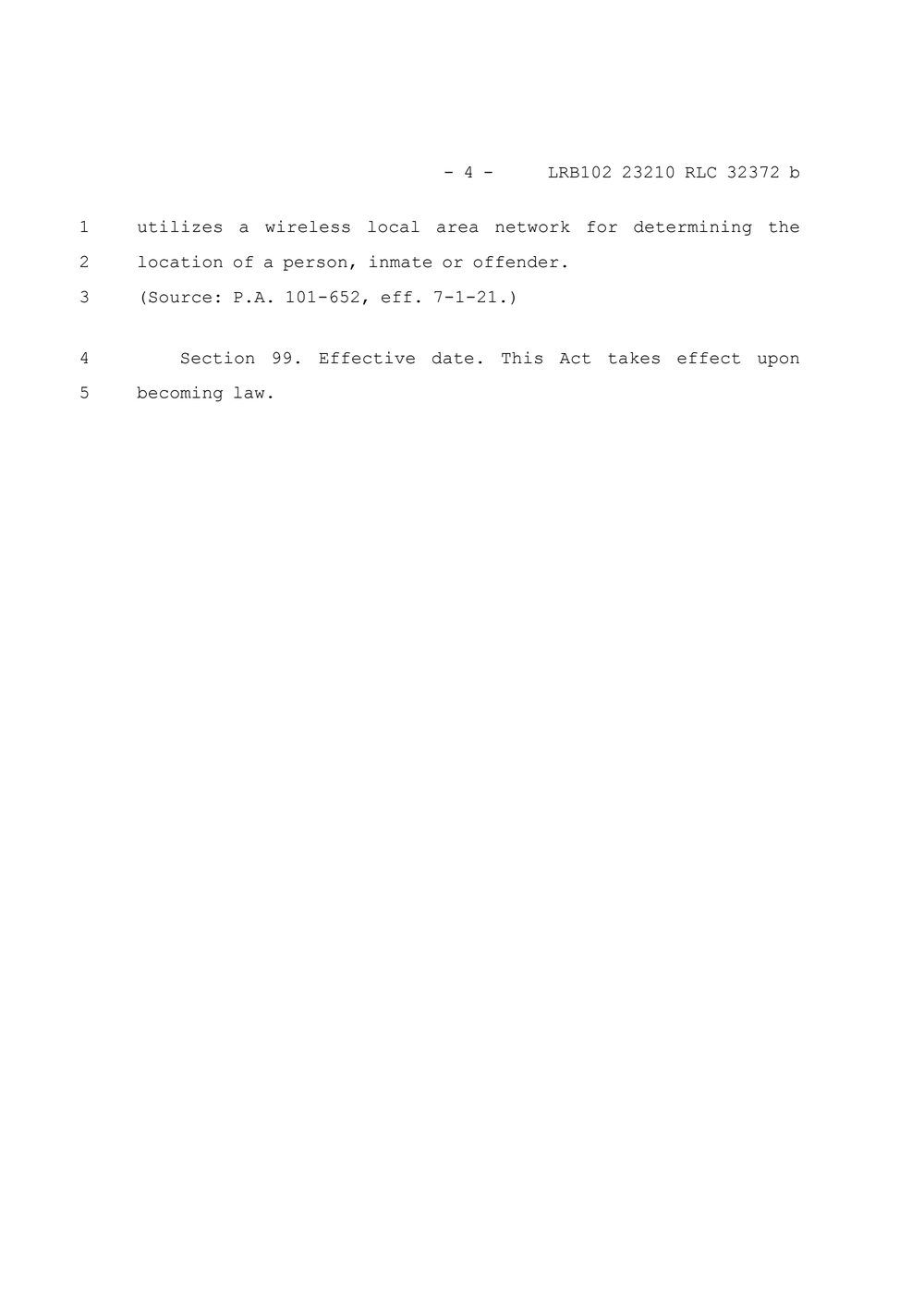
utilizes a wireless local area network for determining the
location of a person, inmate or offender.
(Source: P.A. 101-652, eff. 7-1-21.)
Section 99. Effective date. This Act takes effect upon
becoming law.
1
2
3
4
5
- 4 - LRB102 23210 RLC 32372 b